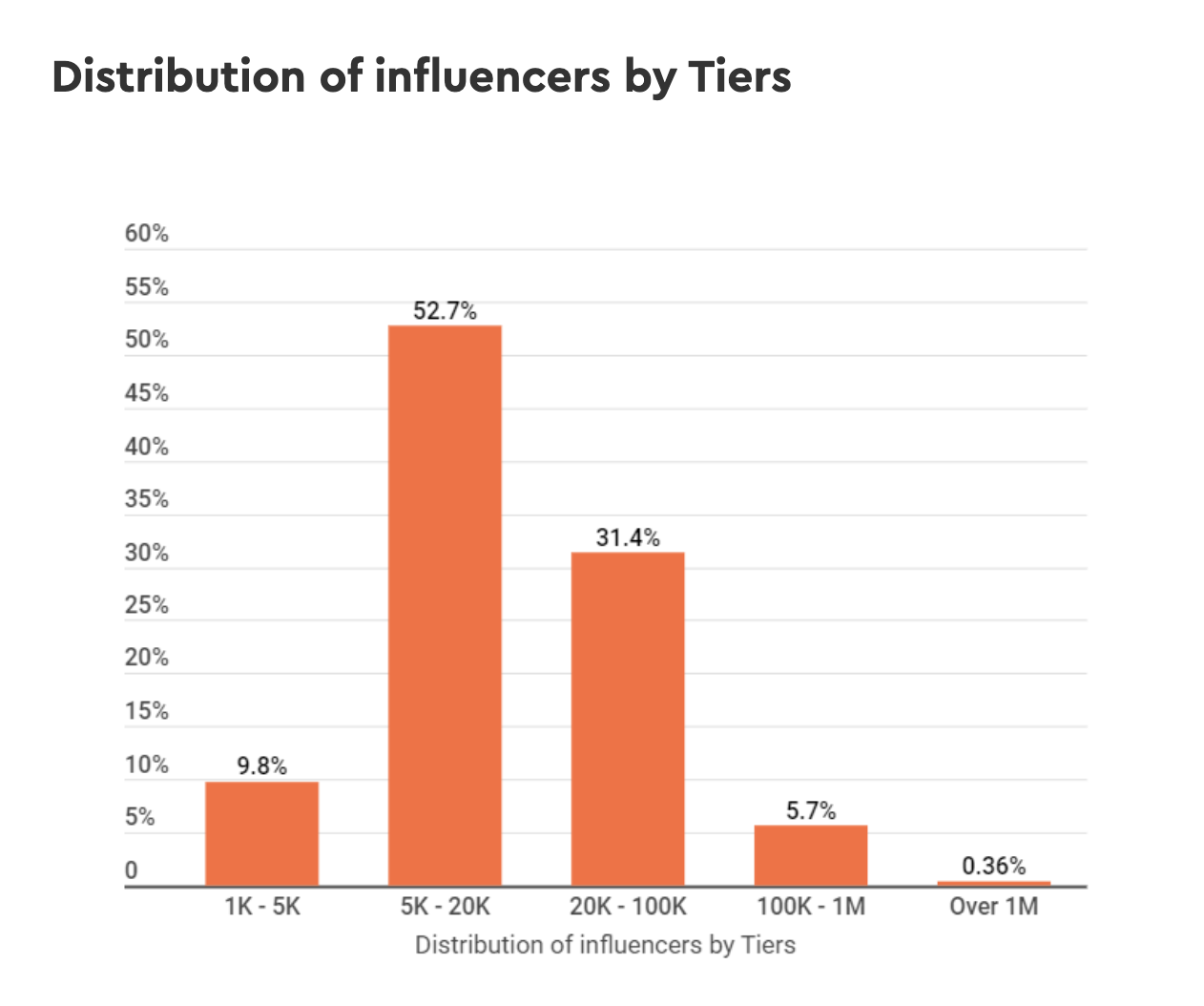The Rise of Influencer Marketing in Malaysia 2021
The Rise of Influencer Marketing in Malaysia
The rise of the internet and social media is giving us more information in the form of content. With social media comes influencer marketing, a form of marketing correlated with the launch of Instagram since 2010. With its 1 billion monthly active users, Instagram has become one of the leading social media platforms for influencer marketing followed by Youtube, LinkedIn and Tiktok.
According to Hype-Journal, there were 11,448,000 Instagram users in Malaysia as of Jan 2020, which covers 34.7% of the entire population of Malaysia! No matter who you are, you will most likely have a social media account or an email address.
The Top 12 Most Active Social Media Platform in Malaysia
- Youtube 68%
- Facebook 67%
- Whatsapp 60%
- Instagram 47%
- Facebook Messager 45%
- WeChat 42%
- Google 41%
- Twitter 41%
- LinkedIn 30%
- Pinterest 26%
- LINE 25%
- Tumblr 23%
What is Influencer Marketing?
You may have heard of the term “influencer marketing” or “social media influencer” or “key opinion leader (KOL)” —Influencer marketing is a hybrid of old and new marketing tools and is a form of online marketing. More accurately, influencer marketing happens when a brand collaborates with an online influencer to market one of its products or services.
What is an Influencer?
Influencers do not have to be celebrities; anyone can be an influencer. An influencer may be a popular wedding photographer on Instagram, a politician who tweets, a public speaker on LinkedIn, or a teen who is always posting byte videos on Tiktok.
Ultimately, an influencer is someone who has the power to affect the purchasing decision of others because of his or her authority, knowledge, and position. These personalities are not merely marketing tools but rather social relationship assets with whom brands can collaborate with to achieve their marketing objectives. Brands love social media influencers because they are a big help in starting trends and encouraging followers to make purchases.
How Influencers Marketing Will Change In 2021?
Micro-influencers will have a greater impact – Do not underestimate the power of micro-influencers just because they’re micro. Many homegrown and lifestyle brands leverage on them instead of using celebrities.
Influencers’ activity will extend beyond Instagram – Keep an eye out for influencers who can market on Youtube and Tiktok—the future is video.
Influencers’ regulation will become tightened – Influencers might carry some responsibility for the content they share on their channels.
Employees and customers will become influencers – Investing in your existing group of people can make a significant impact with the least cost.
Businesses will invest in long-term relationships instead of a one-off campaign – Moving into 2020, brands will tap into long-term collaboration since this saves time, energy, and money, and also allows influencers to build trust with their audience.
Categories of Influencers
- Mega Influencers & Celebrities (>1m followers) – Public figures or celebrities with a vast fan base but slightly lower engagement connection. They may be movie stars, sports stars or musicians. Typically, only major brands engage with mega influencers because they are costly to engage or collaborate with (expect to pay up to $1 million per post for an international celebrity. Furthermore, such personalities can be picky as to whom they partner with. Most of them already have an agent or manager working on their behalf for the purposes of communication and making project deals.
- Macro-influencers (100,000 – 1m followers) – Sometimes called “new celebrity”, macro-influencers are simply those who are famous in their local community. They create high-quality content and are great at engaging with followers. Fortunately, they are more accessible than mega influencers.
- Micro-influencers (5,000 – 100,000 followers) – Micro Influencers are ordinary people coming from any sector such as health and fitness, food, fashion, beauty, sport, entrepreneur and more. They have a niche audience with whom they share a deeper connection (compared to other types of influencers) and therefore tend to have a higher engagement rate.
- Nano-influencers (1,000 – 5,000 followers) – The newest influencers, nano influencers are regular customers who are passionate about various products and services and willing to share (they have less influence than other types of influencers).
Distribution of Influencers by Tiers in Malaysia
Sources from Hype – Journal
Influencers Category
Influencers can be categorised into different category based on their interest in generating their social media contents.
- Lifestyle
- Beauty
- Fashion
- Travelling
- Food
- Sports
- Fitness
- Pets
- Entertainer
- Photographer
- Media / Page
- and etc
Wrong Understanding of Influencers Marketing
- Never think of influencer marketing as about finding someone with an audience and giving them money so they would make positive statements about your product or service.
- Influencer marketing does not always result in quick returns. Use the same kind of slow-and-steady approach as you would in doing content marketing.
- Do not judge the quality of an influencer simply by looking at their number of followers.
- It is important to generalize your approach—make use of multiple influencers and always tailor your approach to the specific influencer.
How to Make It Right for Influencers Marketing?
One rule of thumb to start with, everyone is equal
What is an Engagement Rate?
Engagement, an important metric, is a popular KPI of brand awareness. Engagement Rate or ER is a commonly used benchmark of success on Instagram, as it determines how much interest the influencers have gained with the interactions made. A high- engagement post is more likely to appear on an Instagram feed organically (without the help of someone paying for them to appear).
Engagement Rate Formula
Average Instagram Engagement Rate by Tiers in Malaysia
Average Interaction per Post by Tiers in Malaysia
Sources: Hype – Journal
Besides measuring your engagement rate, it’s important to continuously monitor and keep track of campaign performance: Here are the 5 essential KPIs to measure:
Top 10 Influencers Worldwide
- Instagram (@instagram) – 342 millions (https://www.instagram.com/instagram/?hl=en)
- Cristiano Ronaldo (@cristiano) – 210 millions (https://www.instagram.com/cristiano/?hl=en)
- Ariana Grande (@arianagrande) – 179 millions (https://www.instagram.com/arianagrande/?hl=en)
- The Rock (@therock) – 177millions (https://www.instagram.com/therock/?hl=en)
- Selena Gomez (@selenagomez) – 172 millions (https://www.instagram.com/selenagomez/?hl=en)
- Kylie Jenner (@kyliejenner) – 168 millions (https://www.instagram.com/kyliejenner/?hl=en)
- Kim Kardashian West (@kimkardashian) – 164 millions (https://www.instagram.com/kimkardashian/?hl=en)
- Leo Messi (@leomessi) – 146 millions (https://www.instagram.com/leomessi/?hl=en)
- Beyonce (@beyonce) – 144 millions (https://www.instagram.com/beyonce/?hl=en)
- ene10ta Erre (@neymarjr) – 136 millions (https://www.instagram.com/neymarjr/)
How to Get Started With Influencers Marketing
Yes, anyone or any business can definitely try to reach out to favour influencers directly. However, with the vast amount of influencers around Malaysia or all over other countries and it can be very challenging to handle with people. Otherwise, most businesses or brands will engage with an influencers marketing agency to help in terms of identifying the right influencers for every marketing campaign, negotiating collaboration rate, strategising ideas and mechanics, reporting and measuring results.
Working with the right influencers and a well-planned campaign can have a multitude of great effects on your brands business. If you are interested to discuss more influencers marketing campaign, please feel free to drop us an email at wink@tinkersociety.com or visit us at HERE.










